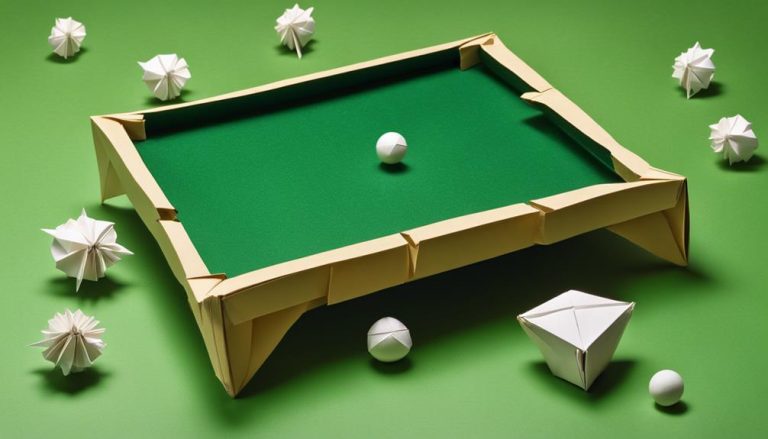General Rules of Vault (Gymnastics)
If you have a passion for gymnastics and aspire to become a master of the vault apparatus, it’s crucial to familiarize yourself with the general rules that govern this discipline. These rules serve as the cornerstone of success in vault gymnastics, encompassing everything from equipment specifications to scoring systems. In this comprehensive article, we will delve into every aspect of vaulting, equipping you with the knowledge and guidance necessary to excel in this exciting gymnastic discipline.

To begin, we will explore the specific equipment requirements for vaulting. Understanding the dimensions and specifications of the vault table, as well as the springboard, is essential in order to perform at your best and ensure your safety. Additionally, we will delve into the scoring system utilized in vault gymnastics, shedding light on the criteria judges use to evaluate and assess performances. By grasping these scoring mechanisms, you will gain valuable insights into how to maximize your scores and showcase your skills effectively.
Safety is paramount in any gymnastic discipline, and vault gymnastics is no exception. Throughout this article, we will outline important safety guidelines that should be followed to minimize the risk of injury during training and competitions. From proper warm-ups to correct body positioning, incorporating these safety practices into your routine will help safeguard your well-being and longevity in the sport.
Finally, we will provide you with training tips and techniques that will enhance your vaulting abilities. From building strength and power to perfecting your technique and execution, these insights will assist you in honing your skills and pushing the boundaries of your performance capabilities.
So, buckle up and prepare to delve into the secrets of excelling in the world of vault gymnastics. By familiarizing yourself with the general rules, equipment specifications, scoring systems, safety guidelines, and training tips, you will be well-equipped to embark on a journey toward mastering the art of vaulting.
Vault Apparatus
To perform vault in gymnastics, you’ll need to familiarize yourself with the vault apparatus. The vault apparatus consists of a runway, a springboard, and a vault table.
The runway is a long, narrow strip that provides the necessary speed and momentum for a successful vault. It’s important to approach the vault with enough speed to generate power, but not so much that it becomes difficult to control.
The springboard is positioned at the end of the runway and acts as a launching pad. It’s a flexible board that allows gymnasts to use their own power to propel themselves into the air. The vault table is where the gymnast performs the actual vault. It’s a padded surface with a flat top that provides stability and support for the gymnast. The vault table should be set at the appropriate height and angle to ensure a safe and effective vault.
When it comes to vault technique, there are a few common mistakes to avoid. One mistake isn’t utilizing the runway properly. It’s important to build up enough speed and maintain control throughout the approach.
Another mistake isn’t utilizing the springboard effectively. The gymnast should use the springboard to generate power and height but also maintain proper technique and body position.
Finally, a common mistake isn’t executing a clean and precise landing. It’s important to stick the landing and avoid any steps or hops, as they can result in deductions.
In summary, familiarizing yourself with the vault apparatus is crucial for performing vault in gymnastics. Understanding how to use the runway, springboard, and vault table effectively will contribute to a successful vault.
Additionally, being aware of common mistakes like improper runway usage, ineffective springboard utilization, and sloppy landings can help improve overall performance.
Equipment Specifications
To ensure proper execution of the vault in gymnastics, it’s essential to understand the equipment specifications. The vault equipment plays a crucial role in ensuring the safety of the gymnast and facilitating their performance.
Here are three key aspects to consider when it comes to vault equipment:
-
Vault Table: The vault table is the main piece of equipment used in the vault event. It consists of a padded, rectangular surface with adjustable height settings. The table must meet specific dimensions and safety standards set by the International Gymnastics Federation (FIG). It should provide adequate cushioning to minimize the impact on the gymnast during vaulting and ensure a stable platform for takeoff and landing.
-
Runway: The runway is the path leading up to the vault table. It’s typically made of a non-slip material to ensure the gymnast’s grip and stability while sprinting towards the table. The runway should be free from any obstacles or debris that could hinder the gymnast’s performance or pose a safety risk.
-
Landing Mat: The landing mat is placed on the other side of the vault table to provide a soft and safe landing surface for the gymnast. It should be thick enough to absorb the impact of the landing and prevent injuries. The landing mat must meet specific size and thickness requirements to ensure consistency and fairness in competition.
Ensuring the proper design, construction, and maintenance of vault equipment is crucial for the safety and success of gymnasts. Coaches, officials, and facility managers must regularly inspect and maintain the equipment to ensure it remains in optimal condition. By adhering to the equipment specifications and prioritizing equipment safety, gymnasts can perform their vaults confidently and focus on achieving their best results.
Approach and Takeoff
To execute a successful approach and takeoff in vault, it’s crucial to maintain proper body alignment and generate explosive leg power.
Your body must be aligned in a straight line from head to toe, with arms extended and shoulders square.
As you sprint towards the vault, focus on driving your legs forcefully into the board to generate maximum power for takeoff.
Proper Body Alignment
You should always maintain proper body alignment during your approach and takeoff in vaulting. This is crucial to ensure optimal performance and prevent common mistakes and injuries. Here are three key points to remember:
-
Posture: Keep your body straight and aligned from head to toe. Avoid leaning or hunching forward, as this can throw off your balance and affect your momentum.
-
Arm Placement: Your arms should be extended above your head, with your shoulders relaxed and your elbows slightly bent. This position helps generate power and control during the takeoff.
-
Core Engagement: Activate your core muscles to maintain stability and control throughout the entire vault. A strong core will help you maintain proper body alignment and execute precise movements.
Explosive Leg Power
Maintain the proper body alignment you established during your approach and takeoff to generate explosive leg power in vaulting.
To enhance your leg power, incorporating plyometric exercises into your training regimen can be highly beneficial. Plyometric exercises involve quick and explosive jumps that engage the muscles in your legs, helping you develop the necessary power for a strong takeoff.
Exercises such as box jumps, depth jumps, and squat jumps can all contribute to increasing your explosive leg power. These exercises focus on building strength and speed in your leg muscles, enabling you to generate more force when propelling yourself off the vaulting table.
Flight Phase
During the flight phase of the vault, your body position plays a crucial role in determining the success of your performance. Maintaining a tight, straight body line with proper alignment is essential for maximizing your height and distance.
Additionally, your landing technique after the flight phase is equally important, as it can greatly impact your overall score. It’s crucial to stick the landing, demonstrating control and stability.
Lastly, proper timing is vital during the flight phase, as mistiming can result in incomplete rotations or missed hand placements, leading to deductions.
Body Position During Flight
To achieve proper body position during the flight phase of the vault in gymnastics, maintain a straight and extended posture. This is crucial for maximizing your height and distance while in the air.
Here are three key points to focus on:
-
Keep your body aligned from head to toe. A straight line from your head, through your shoulders, hips, and legs, ensures optimal aerodynamics and stability during flight.
-
Extend your arms fully overhead. This helps in maintaining balance and control, as well as creating a longer lever for generating power during takeoff and throughout the vault.
-
Engage your core muscles. A strong core provides stability and control during flight, allowing you to maintain proper body alignment and execute precise movements.
Landing Technique After Flight
Achieve a controlled and stable landing by focusing on your landing technique after the flight phase in vault gymnastics. Your landing technique plays a crucial role in maintaining body control and preventing injuries.
As you come out of the flight phase and approach the landing, it’s important to maintain a tight body position and engage your core muscles. Keep your arms and legs extended, creating a straight line from head to toe. This will help you absorb the impact and distribute the force evenly throughout your body.
Land with your feet together and slightly bent knees to absorb the shock. Remember to maintain your balance and avoid any sudden movements that could throw you off balance.
Importance of Proper Timing
Maintain precise timing during the flight phase to ensure a smooth transition into the landing in vault gymnastics. Proper execution of this phase is crucial for technique improvement and maximizing your performance. Here are three key points to consider:
-
Consistency: Timing is essential in achieving consistency in your vault. By maintaining a consistent rhythm and timing during the flight phase, you can ensure that your body is in the correct position for a successful landing.
-
Power and Control: Proper timing allows you to generate the necessary power for your vault while maintaining control over your movements. It enables you to execute each skill with the right amount of force and precision.
-
Injury Prevention: Timing plays a significant role in reducing the risk of injuries. When you execute your movements with precise timing, you minimize the chances of landing awkwardly or unevenly, which can lead to sprains, strains, or more severe injuries.
Landing and Dismount
When landing and dismounting in vault gymnastics, focus on maintaining proper form and using controlled movements. Landing technique and dismount execution are crucial aspects of a successful vault routine. To ensure a safe and effective landing, gymnasts must adhere to specific techniques that promote stability and minimize the risk of injury. Additionally, executing a well-controlled and precise dismount is essential for a smooth transition and a strong finish to the routine.
To better understand the key elements of landing and dismounting, let’s explore the table below:
| Landing Technique | Dismount Execution |
|---|---|
| Bend knees and absorb the impact | Generate height and distance |
| Keep the chest up and the core engaged | Maintain body control and balance |
| Land with both feet simultaneously | Stick the landing with minimal movement |
| Maintain a slight forward lean | Execute a clean and controlled dismount |
| Avoid excessive backward or sideways movement | Demonstrate proper body alignment |
By focusing on these techniques, gymnasts can optimize their landings, showcasing strength, control, and precision. Proper landing technique involves bending the knees to absorb the impact, which helps to distribute the force evenly throughout the body. Maintaining an engaged core and an upright chest promotes stability and prevents excessive leaning or instability.
Similarly, dismount execution plays a crucial role in the overall performance. Generating maximum height and distance during the dismount is essential for a visually appealing routine. Gymnasts should strive to maintain body control and balance throughout the entire dismount, ensuring a smooth and seamless transition from the vault to the landing. Sticking the landing requires precise timing and coordination, with the goal of minimal movement upon contact with the mat.
Scoring System
To understand the scoring system in vault gymnastics, you need to familiarize yourself with the criteria used to evaluate performances. The scoring system is based on a combination of difficulty and execution, with deductions made for mistakes or errors. Here are the key aspects of the scoring system:
-
Difficulty: The scoring system takes into account the difficulty of the vault performed. Each vault has a predetermined difficulty value assigned to it, which is based on the elements and skills involved. The more complex and challenging the vault, the higher the difficulty score.
-
Execution: The execution of the vault is evaluated based on technique, form, and precision. Judges closely analyze the athlete’s body position, body alignment, and control throughout the entire vault. Any errors or flaws in technique can result in deductions from the overall score.
-
Technique Analysis: Judges also assess the technique used in the vault, including the approach, takeoff, flight, and landing. They look for proper body positioning, timing, and power generated during the vault. A well-executed technique contributes to a higher score, while mistakes or flaws can lead to deductions.
The scoring system in vault gymnastics aims to reward athletes who achieve a high level of difficulty while demonstrating exceptional execution and technique. It provides a standardized method of evaluating performances and allows for fair and objective scoring.
As a gymnast, understanding the scoring system can help you identify areas for improvement and strive for higher scores in your vault routines.
Deductions and Penalties
As a gymnast, you should be aware of the deductions and penalties that can affect your overall score in vault gymnastics. Deductions are subtracted from the total score based on the mistakes made during the routine, while penalties are imposed for violating the rules or regulations. Understanding the deduction calculation and judging criteria is crucial to maximizing your score and minimizing errors.
Deduction calculation in vault gymnastics takes into account various factors such as form, execution, technique, difficulty, and landing. Judges evaluate the execution of each skill and deduct points for mistakes such as bent knees, flexed feet, lack of body control, and imprecise hand placement on the vault table. These deductions are usually based on a predetermined scale, with each mistake having a specific point value assigned to it.
The judging criteria for vault gymnastics focus on several key aspects. Judges assess the difficulty of the routine by evaluating the skills performed and the level of complexity. They also consider the execution of each skill, looking for precision, control, and proper technique. Additionally, judges pay close attention to the landing, expecting a controlled and stable finish.
It is important to note that different vaults have different difficulty ratings, which directly impact the potential deductions and penalties. The more difficult the routine, the higher the potential deductions if mistakes are made.
To avoid deductions and penalties, gymnasts must strive for perfection in every aspect of their routine. This requires precise technique, impeccable form, and strong body control. Practicing consistently and seeking feedback from coaches can help identify areas for improvement and minimize mistakes.
Safety Guidelines
To ensure the safety of gymnasts, it’s essential that you adhere to the designated safety guidelines while performing vault routines. Safety precautions and injury prevention are of utmost importance in gymnastics. Here are three key guidelines to follow:
-
Proper Warm-up: Before attempting any vault routine, it’s crucial to warm up adequately. This helps to loosen your muscles, increase blood flow, and reduce the risk of injury. Perform dynamic stretches and exercises that target the muscles used in vaulting, such as the legs, core, and upper body. Additionally, take the time to stretch your wrists and ankles, as these areas are prone to injury during vaulting.
-
Appropriate Equipment: Use vaulting equipment that’s in good condition and meets safety standards. Inspect the vaulting table for any damages or defects before use. Ensure that the runway and landing mat are clean and free from debris. It’s also important to wear appropriate safety gear, such as a helmet and wrist guards, to provide additional protection during vaulting.
-
Spotting and Supervision: Always perform vault routines under the supervision of a qualified coach. A coach can provide guidance, correct technique, and ensure your safety. When attempting new or challenging vaults, it’s recommended to have a spotter present. A spotter can help prevent falls and provide assistance if needed.
Training and Technique Tips
Improve your vaulting skills with effective training and technique. Training drills are essential for mastering the vault and achieving the best possible performance. Incorporating these drills into your training routine will help you build strength, flexibility, and body control, all of which are crucial for executing a successful vault.
One important aspect of vault training is practicing your run-up. A strong and controlled run-up is the foundation for a powerful vault. Focus on maintaining a consistent speed and rhythm, and practice accelerating into the vaulting table. Incorporate sprint drills and plyometric exercises into your training to improve your explosive power.
In addition to the run-up, it’s crucial to work on your technique for the different phases of the vault. Practice your hurdle step, block, and post-flight technique to ensure a smooth and efficient execution. Utilize video analysis to identify areas for improvement and make necessary adjustments to your technique.
While training for the vault, it’s crucial to prioritize injury prevention. Warm up adequately before each training session and include dynamic stretches to prepare your muscles for the demands of the vault. Strengthen your core and upper body to provide stability and support during the vault. Incorporate balance exercises and proprioceptive training to improve body awareness and reduce the risk of falls or missteps.
Remember to listen to your body and take rest days when needed. Overtraining can lead to injuries and hinder your progress. By incorporating these training drills and prioritizing injury prevention, you’ll be well on your way to improving your vaulting skills and achieving success in gymnastics.
Frequently Asked Questions
What Are the Different Types of Vault Apparatus Used in Gymnastics?
When it comes to the different types of vault apparatus used in gymnastics, safety precautions during your vault routine are essential.
Understanding the various types of vault apparatus, such as the vaulting table, horse, or mushroom, can help you choose the right equipment for your training.
It’s crucial to follow safety guidelines, such as proper warm-up, spotting techniques, and using appropriate padding and mats.
What Are the Specific Equipment Specifications for the Vault Apparatus?
To ensure your safety and success on the vault apparatus, it’s crucial to understand the equipment specifications and follow the necessary guidelines.
The vault must be 1.2 meters wide and 1.35 meters long, with a height of 1.35 meters. The landing mat should be at least 20 centimeters thick to provide enough cushioning.
These specifications ensure consistency and fairness in competitions, while also prioritizing your well-being.
How Should Gymnasts Approach and Take Off During a Vault Routine?
When performing a vault routine in gymnastics, focusing on your approach techniques and taking off mechanics is important. Your approach should be precise and controlled, allowing you to generate the necessary power for a successful vault.
As you approach the vault, maintain a strong body position and prepare for take off. The mechanics of your take-off should involve a quick and explosive jump off the springboard, utilizing your leg and arm strength to propel yourself into the air.
What Should Gymnasts Focus on During the Flight Phase of a Vault?
During the flight phase of a vault, you should focus on perfecting your technique and timing. This crucial part of the routine requires precision and grace. By honing your technique, you can ensure a smooth and controlled flight through the air. Pay close attention to your body position, arm placement, and leg extension.
Additionally, timing is key to executing a successful vault. Aim to time your movements and actions with precision, allowing for maximum power and height.
What Are Some Common Deductions and Penalties in the Scoring System for Vault?
When it comes to vault in gymnastics, it’s important to understand the common deductions and penalties in the scoring system. These deductions are based on the judging criteria and can greatly affect your overall score.
Some common deductions include:
- Steps on the landing
- Lack of height or distance
- Bent knees
- Not sticking the landing
It’s crucial to pay attention to these details and work on perfecting your form to avoid these deductions and maximize your score.






